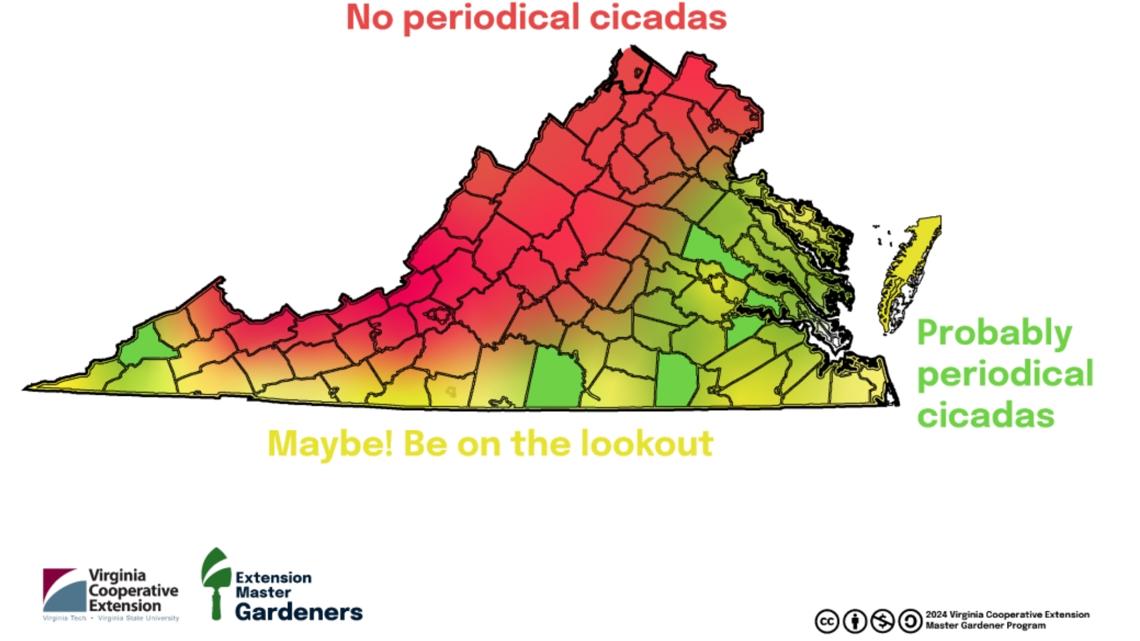VIRGINIA, USA — That loud, distinct buzzing. Those empty exoskeleton shells attached to trees (or worse, your car).
It's almost time for trillions of cicadas to emerge from the ground and create a cacophony that will be heard across the Commonwealth of Virginia. It'll be nearly impossible to miss them.
Two periodic broods of cicadas will simultaneously emerge this spring: the largest brood of 13-year cicadas, known as Brood XIX, will co-emerge with a midwestern brood of 17-year cicadas, Brood XIII.
It's the first time since 2015 that a 13-year brood is emerging in the same year as a 17-year brood, according to the University of Connecticut. And it's the first time since 1803 since different life cycles of Brood XIX and Brood XIII co-emerged.
Here in Virginia, we will only see (and hear) Brood XIX, alongside annual cicadas that emerge every year. Here is when and where we can expect the cicadas to make their presence known.
Where we can expect to see cicadas: Virginia county map of cicada broods
The exact location where periodical cicada broods emerge can require some educated guesswork and prediction. For Brood XIX, entomologists believe the southern and central parts of Virginia will most likely encounter the 13-year insects.
A heat map created by Virginia Tech shows some of the likeliest counties that will see this 13-year brood are Brunswick, Halifax, Hanover, Charles City, and Prince George counties.
Other counties that are likely to see Brood XIX include James City County, York, Gloucester, Surry, Middlesex, Lancaster, Chesterfield, Prince George, Caroline, King William, and King and Queens.


When are the cicadas coming in 2024?
Entomologists at NC State University say cicadas only emerge once the ground temperature reaches 64 degrees. Professor of Entomology Clyde Sorenson said it'll happen quickly and will look like someone used a shotgun to shoot holes in your yard.
He said we can expect the emergence to start before the end of April, with larger numbers of the insects beginning to emerge in the days that follow. Brood XIX numbers are expected to peak in May, and they will all be gone by early June.
Will Virginia see a double brood in 2024?
In addition to Brood XIX cicadas, which emerge every 13 years, another brood that only emerges once every 17 years is making its presence known in 2024: Brood XIII.
While there has been a lot of hype about a "cicada-pocalypse" or "double brood" overwhelming parts of the United States, the reality is there is very little overlap between Brood XIX and Brood XIII. The larger Brood XIX is located mostly in the southern U.S. while Brood XIII is more limited to parts of the Midwest, particularly in Illinois.
As a result, Virginians should expect to only see the Brood XIX periodic cicadas, in addition to the annual cicadas.


What's the difference between periodic and annual cicadas?
Even if you're not in one of the areas where Brood XIX is expected to have a large presence, that doesn't mean you won't see or hear any cicadas this year.
Periodic cicadas have cycles where they only emerge once every 13 years (like Brood XIX) or 17 years (like Brood XIII). However, "annual" cicadas appear, as their name implies, every single year.
According to the Virginia Places website, annual cicadas don't usually begin to emerge in Virginia until May or June, right around the time the periodical cicadas disappear.
Visually, periodical cicadas are black in color with bright red eyes. Virginia Tech entomologists say annual cicadas have black-green coloring and blend in more easily with vegetation.




Are cicadas harmful?
They might be big, creepy and most of all loud, but cicadas are harmless to pets and people, and relatively harmless to plants.
Experts said cicadas can cause problems for young trees and nurseries when their mating and nesting weigh down and break branches. However, they only last about a month above ground, and no, they aren't dangerous.
Unlike locusts, which eat plants, cicadas get their nutrients from sap and small branches. Most trees, however, will remain unharmed and typically aren't a problem for home gardeners.
They don't bite and are safe for people, including children, to hold and handle.
Why is all of this happening?
So we know when and where cicadas are emerging, but you might still be wondering: why do cicadas do this in the first place and what are they up to after they emerge?
Here's a very simple look at their life cycle:
- They hatch from an egg
- They burrow underground, where they will drink from plant roots for most of their lives
- They leave the underground and molt into adults, leaving behind shells of their old bodies as well as half-inch holes in the ground from where they emerged
- The males make that distinct buzzing sound to attract females
- Males and females court and mate
- Females lay fertilized eggs in the branches of plants, and the cycle continues
- They die


Periodical cicadas are especially unusual because of their long life cycles and their infrequent mass emergences. According to entomologists at the University of Connecticut, periodical cicadas only exist in eastern North America.
There are a total of seven periodical species: four have 13-year life cycles while the other three have 17-year life cycles.
Periodical cicada emergences across different regions are not synchronized, so among those seven species are approximately 15 different populations that are dubbed "broods" which are categorized on the years they emerge.
Because of the different cycles of 13 and 17 years, occasionally two different broods may emerge in the same year, like what is happening this year with the 13-year Brood XIX and the 17-year Brood XIII cicadas.
WFMY and WCNC in North Carolina contributed to this report.

